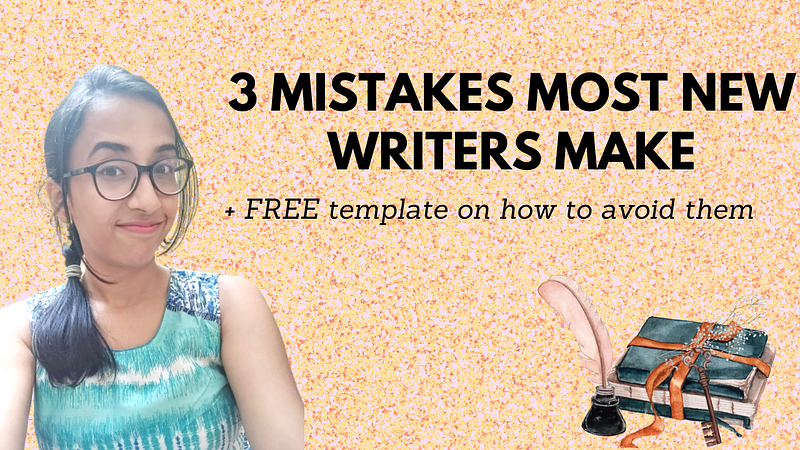3 Common Mistakes Most New Writers Make
Plus, a free template on how you can avoid them.

Plus, a free template on how you can avoid them.
After working with 20+ new writers on Project Medium, I’ve found that when writers start putting their work out there in front of the world, there are three mistakes they commonly make.
In this post, I’m going to dissect these mistakes and discuss actionable tips on how you can get past them.
Before we get started, here’s a link if you’d like to watch the same in video format.
1. Lack of consistency in writing
I understand you might have a full-time job, a family, or your studies to take care of. You can’t publish a new article every day. It’s just not possible.
But if you want to be a writer, it’s essential that you practice your writing muscle every day.
If you can’t find time to write a full-length article, write something in your journal. Write the 280 characters of a Tweet. Write a thoughtful comment on someone else’s article on Medium.
It doesn't matter what you write and how long it is. What matters is that you think creatively and put those writing muscles to work.
After all, writing is more craft than art. And like any other craft, it needs to be practiced every day before you can be flawless.
2. Lack of proper structure and presentation
I’ve read so many articles where the core idea is unbelievably inspiring. But because of improper presentation, they are scattered everywhere. There isn’t a flow to the article. It’s just a bunch of ideas crammed in together, leaving the reader more confused than enlightened.
To make sure something like this doesn’t happen to your writing, here’s a template I use in my most successful articles. Feel free to incorporate it in your writing and make it your own.
Part one: Introduction
Start with a story, a fun fact, or an interesting anecdote that establishes in the mind of the reader why what you’re talking about is important and why they should care about it.
If you hit them with a huge block of text when they come to your article, they are going to be super confused.
Don’t make that mistake. Give them a reason to keep reading. Let them know why your topic matters.
Part two: Give lessons and establish credibility
Most successful articles present a problem in the introduction and then give lessons to the reader on how to solve that problem.
The second part of your article should be about laying down the ways in which your problem can be solved. The important part here is to establish credibility.
Don’t just state your opinions. Back them up by peer-reviewed journal papers. You can find them on Google Scholar or ResearchGate. Readers love a well-researched article full of credible backlinks.
Part three: Actionable takeaways
Once you’ve laid down science-backed solutions to the problem, the next part is about giving the readers takeaways they can implement in their lives.
Break down the lessons and make them actionable. Write them in such a way that a reader can apply them directly without having to read a ton of other articles to get more clarity on the matter.
Part four: The conclusion
A powerful conclusion throws back to the introduction, sums up all that has already been said in the article, and leaves the reader with a strong sense of positivity.
Your goal is to make the reader feel smarter after reading your work. Never focus on their fears. Instead, focus on where they can be if they apply your tips. That will leave them feeling empowered and wanting to implement the tips right away.
3. The fear of rejection
Fear of rejection is not bad per se. I mean, I have 8000 followers on Medium, and I’m still afraid of what will happen if the editors of my target publication reject my story.
But this fear becomes crippling if it prevents you from submitting your story to bigger publications.
I’ve seen so many new writers struggle with this; it breaks my heart. If you’re so afraid of rejection that you “settle” for a smaller publication, you’re essentially rejecting yourself before anyone else can reject you. How unfair is that?
Rejection is a big part of the learning process. You’ll either find a different publication that your story will be a better fit in, or you’ll get invaluable feedback that will help you improve as a writer.
Either way, you’ll learn. So don’t rob yourself of this opportunity.
Check out my 3-month course Project Medium: Make your first $100 here. In addition to detailed videos explaining how you can find success on Medium, you’ll find exclusive checklists, cheat-sheets, and a mastermind group that meets every Sunday for an hour-long accountability session discussing growth strategies and testing out new ideas before publishing
If you’re a writer passionate about reaching your full potential and are willing to help other writers in their journey, join this community of writers supporting each other here. It’s free and has 150+ writers dedicated to making it big on Medium.
